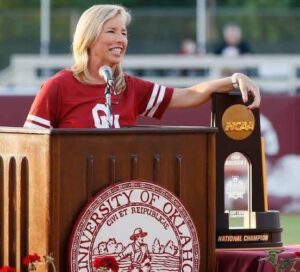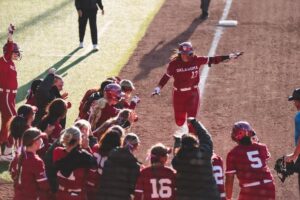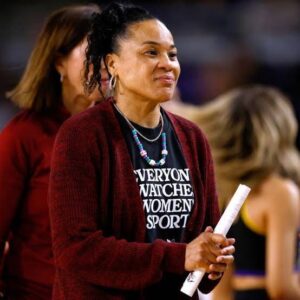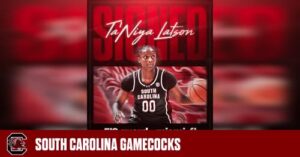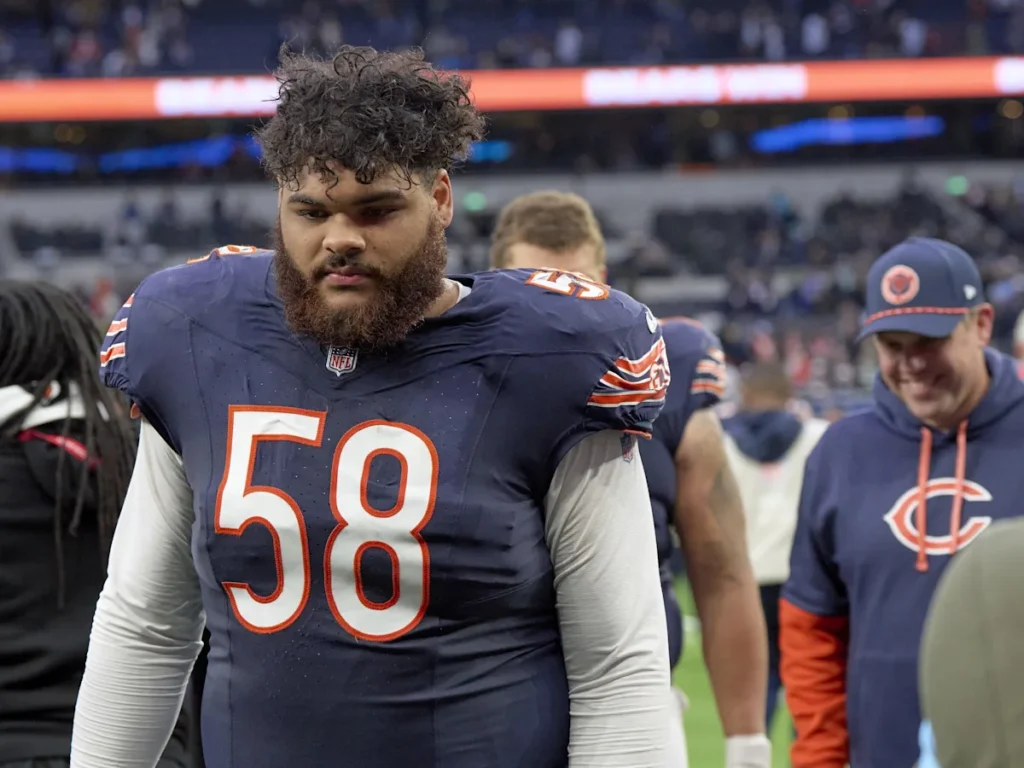
Following the NFL Draft, the Chicago Bears are considering moving Darnell Wright to left tackle.
The NFL Draft is one of the most important events in the league’s offseason, as teams look to bolster their rosters with the next wave of young talent. For the Chicago Bears, the 2023 NFL Draft brought hope for a better future, especially after their major trade with the Carolina Panthers, which gave them additional picks and opened up opportunities to fill critical holes on the roster. One of the key selections the Bears made in the 2023 Draft was Darnell Wright, a standout offensive tackle from Tennessee, who they selected with the 10th overall pick. This decision was part of their broader strategy to improve their offensive line and protect their franchise quarterback, Justin Fields.
The Bears’ offensive line has been a long-standing issue, with inconsistent play at key positions, especially at tackle. Wright’s arrival was viewed as a potential solution to their struggles, but now, the team is reportedly considering a move that could shake things up even further: switching Wright from right tackle to left tackle. This would be a significant adjustment, not just for Wright but also for the entire offensive line. In this article, we’ll explore why the Bears are considering such a move, what it would mean for Wright, and the potential impact on the team as a whole.
The Chicago Bears have struggled with offensive line play for years. Since the 2018 season, the team has regularly ranked near the bottom of the league in terms of pass protection and run blocking. This is a serious issue when trying to develop a young quarterback like Justin Fields, who relies on solid protection to make plays down the field. Fields showed tremendous promise in 2022, particularly with his ability to extend plays with his legs, but even his elite athleticism couldn’t compensate for poor offensive line play.
In 2022, the Bears finished 29th in the NFL in sack rate, allowing 58 sacks on Fields. This was a stark reminder of just how fragile the Bears’ offensive line had become. Additionally, they were 31st in rushing yards per game, a statistic that reflects not only the Bears’ inability to open up lanes for running backs but also the struggles in the passing game. The offensive line was a key factor in these disappointing results.
Therefore, when the Bears had the opportunity to address this position in the 2023 NFL Draft, they knew it was critical to add someone who could start immediately and help protect their young quarterback. Darnell Wright fit the bill.
Darnell Wright was regarded as one of the top offensive tackle prospects in the 2023 draft class. Standing 6’5” and weighing around 330 pounds, Wright has an ideal build for a professional tackle. What impressed scouts and analysts about Wright was his consistency and ability to handle elite pass rushers, particularly his impressive performance against some of the best defensive players in college football during his time at Tennessee.
Wright spent most of his college career playing right tackle, where he developed a reputation as a formidable force in both run blocking and pass protection. Over his time with the Volunteers, he faced a range of elite edge rushers and handled himself well in most matchups, showcasing his skill set in both power and technique. His ability to protect the blindside of the quarterback at the next level, however, was always going to be in question.
Left tackle is widely regarded as the most important position on the offensive line, often tasked with protecting the quarterback’s blindside. For a right-handed quarterback like Justin Fields, the left tackle is the player tasked with blocking the most dangerous pass rushers. The ability to play left tackle requires more than just physical attributes; it requires elite footwork, balance, and the mental fortitude to handle the immense pressure that comes with being the last line of protection. This is why moving Wright from right tackle to left tackle is such a significant move.
The Bears are reportedly considering moving Wright to left tackle for a few key reasons, the most prominent of which is the desire to find a long-term solution to their left tackle position.
One of the key reasons behind the decision to move Wright is the development of Teven Jenkins, the Bears’ second-round pick in the 2021 NFL Draft. Jenkins, who was originally drafted as a right tackle, was moved to left guard in 2022 due to injuries and the need for flexibility on the line. However, Jenkins played admirably at guard and became a steady presence in the interior.
In 2023, Jenkins is expected to continue his growth at the guard position, and his success there may free up the right tackle spot for Wright. Jenkins’ progress at guard and his previous experience at tackle could lead the Bears to believe that Jenkins’ best future role is inside, while Wright can take over the right tackle duties.
As mentioned, left tackle is considered the most important position on the offensive line, especially for a right-handed quarterback like Justin Fields. While Wright is a talented player, his move to left tackle represents the Bears’ desire to solidify Fields’ protection. This decision would allow the team to pair a young, talented player like Wright with Fields on the left side of the line, which would ideally give Fields the security he needs to progress in his development.
The left tackle position requires an athlete who is both quick and powerful, capable of protecting the quarterback’s blindside in situations where the defense is sending its best pass rushers. If Wright’s transition to left tackle is successful, it would allow the Bears to address two problems at once: finding a dependable left tackle and ensuring that Fields’ progression isn’t hindered by poor pass protection.
One of the reasons the Bears are willing to move Wright is the depth of talent on the roster, particularly in the 2023 NFL Draft class. The Bears addressed a variety of positions, including wide receiver, defensive line, and linebacker, with their remaining picks. This gives them the flexibility to experiment with moving Wright to left tackle without worrying about leaving the team thin at other positions.
With solid depth across the roster, the Bears are in a position where they can afford to take risks on the offensive line, knowing they have the talent elsewhere to support this change.
While the Bears’ decision to move Wright to left tackle is understandable, it is not without its challenges. The transition from right tackle to left tackle is difficult for many players, as it requires a shift in footwork, hand placement, and overall approach to the position.
The most obvious challenge Wright would face in moving to left tackle is adjusting to the different footwork and technique required. At right tackle, Wright would have had his right foot in the back and his left foot forward in his stance. When moving to left tackle, he would need to reverse this, leading with his right foot. This seemingly small shift in footwork can be incredibly difficult for many players, especially those who have spent years refining their technique as a right tackle.
Left tackles must also possess the ability to mirror the movements of edge rushers, who tend to favor rushing from the outside. This requires excellent lateral movement and balance, which Wright will need to hone if he is to be effective at left tackle.
Left tackle is one of the most high-pressure positions on the field, as it is directly responsible for protecting the quarterback’s blindside. For a player like Wright, the mental pressure to perform at a high level every week will be immense, particularly in a market like Chicago where expectations are high. One bad performance could lead to criticism, especially if Justin Fields struggles as a result of poor protection.
Wright has spent most of his career playing right tackle, and even though he possesses the athleticism and talent to succeed on the left side, there is still a significant learning curve to overcome. There’s also the question of whether the Bears’ coaching staff is confident in their ability to develop Wright quickly enough to meet the demands of the position. Given how critical the left tackle spot is to protecting Justin Fields, it will be crucial that Wright’s transition is smooth and that he can adjust to his new role quickly.
If Wright successfully makes the transition to left tackle, it would be a significant step toward improving the Bears’ offensive line as a whole. The Bears would then have two young and talented tackles in Wright and the potentially emerging Jenkins, with a solid interior line led by veterans like Cody Whitehair and Nate Davis. This could give the Bears the foundation they need to provide Justin Fields with the protection he needs to take the next step as a quarterback.
A solid offensive line also opens up opportunities for the running game. The Bears’ running back committee, led by Khalil Herbert, would benefit greatly from better blocking upfront. If the offensive line becomes a strength rather than a weakness, the entire offense could thrive, and the Bears could develop into a more balanced team capable of competing in the NFC North.
The decision to move Darnell Wright to left tackle is a risky but potentially rewarding move for the Chicago Bears. With the team in the midst of rebuilding around Justin Fields, securing strong protection on the offensive line is one of the most important steps they can take. While Wright’s transition to left tackle comes with its challenges, the Bears believe in his talent and potential to thrive in this new role. If Wright can make a successful adjustment, the Bears’ offensive line could take a major step forward, helping Fields develop into the franchise quarterback they hope he can become.
Ultimately, the Bears’ decision to experiment with Wright at left tackle will be a critical one for their future. It’s a move that reflects their commitment to building a competitive team around Justin Fields, but only time will tell if it will pay off. The stakes are high, and the pressure is on, but if Wright can meet the challenge, the Bears may have found the long-term solution to their left tackle dilemma.
For the Chicago Bears, the 2023 NFL Draft brought hope for a better future, especially after their major trade with the Carolina Panthers, which gave them additional picks and opened up opportunities to fill critical holes on the roster. One of the key selections the Bears made in the 2023 Draft was Darnell Wright, a standout offensive tackle from Tennessee, who they selected with the 10th overall pick. This decision was part of their broader strategy to improve their offensive line and protect their franchise quarterback, Justin Fields.
The Bears’ offensive line has been a long-standing issue, with inconsistent play at key positions, especially at tackle. Wright’s arrival was viewed as a potential solution to their struggles, but now, the team is reportedly considering a move that could shake things up even further: switching Wright from right tackle to left tackle. This would be a significant adjustment, not just for Wright but also for the entire offensive line. In this article, we’ll explore why the Bears are considering such a move, what it would mean for Wright, and the potential impact on the team as a whole.
The Chicago Bears have struggled with offensive line play for years. Since the 2018 season, the team has regularly ranked near the bottom of the league in terms of pass protection and run blocking. This is a serious issue when trying to develop a young quarterback like Justin Fields, who relies on solid protection to make plays down the field. Fields showed tremendous promise in 2022, particularly with his ability to extend plays with his legs, but even his elite athleticism couldn’t compensate for poor offensive line play.
In 2022, the Bears finished 29th in the NFL in sack rate, allowing 58 sacks on Fields. This was a stark reminder of just how fragile the Bears’ offensive line had become. Additionally, they were 31st in rushing yards per game, a statistic that reflects not only the Bears’ inability to open up lanes for running backs but also the struggles in the passing game. The offensive line was a key factor in these disappointing results.
Therefore, when the Bears had the opportunity to address this position in the 2023 NFL Draft, they knew it was critical to add someone who could start immediately and help protect their young quarterback. Darnell Wright fit the bill.
Darnell Wright was regarded as one of the top offensive tackle prospects in the 2023 draft class. Standing 6’5” and weighing around 330 pounds, Wright has an ideal build for a professional tackle. What impressed scouts and analysts about Wright was his consistency and ability to handle elite pass rushers, particularly his impressive performance against some of the best defensive players in college football during his time at Tennessee.
Wright spent most of his college career playing right tackle, where he developed a reputation as a formidable force in both run blocking and pass protection. Over his time with the Volunteers, he faced a range of elite edge rushers and handled himself well in most matchups, showcasing his skill set in both power and technique. His ability to protect the blindside of the quarterback at the next level, however, was always going to be in question.
Left tackle is widely regarded as the most important position on the offensive line, often tasked with protecting the quarterback’s blindside. For a right-handed quarterback like Justin Fields, the left tackle is the player tasked with blocking the most dangerous pass rushers. The ability to play left tackle requires more than just physical attributes; it requires elite footwork, balance, and the mental fortitude to handle the immense pressure that comes with being the last line of protection. This is why moving Wright from right tackle to left tackle is such a significant move.
The Bears are reportedly considering moving Wright to left tackle for a few key reasons, the most prominent of which is the desire to find a long-term solution to their left tackle position.
One of the key reasons behind the decision to move Wright is the development of Teven Jenkins, the Bears’ second-round pick in the 2021 NFL Draft. Jenkins, who was originally drafted as a right tackle, was moved to left guard in 2022 due to injuries and the need for flexibility on the line. However, Jenkins played admirably at guard and became a steady presence in the interior.
In 2023, Jenkins is expected to continue his growth at the guard position, and his success there may free up the right tackle spot for Wright. Jenkins’ progress at guard and his previous experience at tackle could lead the Bears to believe that Jenkins’ best future role is inside, while Wright can take over the right tackle duties.
As mentioned, left tackle is considered the most important position on the offensive line, especially for a right-handed quarterback like Justin Fields. While Wright is a talented player, his move to left tackle represents the Bears’ desire to solidify Fields’ protection. This decision would allow the team to pair a young, talented player like Wright with Fields on the left side of the line, which would ideally give Fields the security he needs to progress in his development.
The left tackle position requires an athlete who is both quick and powerful, capable of protecting the quarterback’s blindside in situations where the defense is sending its best pass rushers. If Wright’s transition to left tackle is successful, it would allow the Bears to address two problems at once: finding a dependable left tackle and ensuring that Fields’ progression isn’t hindered by poor pass protection.
One of the reasons the Bears are willing to move Wright is the depth of talent on the roster, particularly in the 2023 NFL Draft class. The Bears addressed a variety of positions, including wide receiver, defensive line, and linebacker, with their remaining picks. This gives them the flexibility to experiment with moving Wright to left tackle without worrying about leaving the team thin at other positions.
With solid depth across the roster, the Bears are in a position where they can afford to take risks on the offensive line, knowing they have the talent elsewhere to support this change.
While the Bears’ decision to move Wright to left tackle is understandable, it is not without its challenges. The transition from right tackle to left tackle is difficult for many players, as it requires a shift in footwork, hand placement, and overall approach to the position.
The most obvious challenge Wright would face in moving to left tackle is adjusting to the different footwork and technique required. At right tackle, Wright would have had his right foot in the back and his left foot forward in his stance. When moving to left tackle, he would need to reverse this, leading with his right foot. This seemingly small shift in footwork can be incredibly difficult for many players, especially those who have spent years refining their technique as a right tackle.
Left tackles must also possess the ability to mirror the movements of edge rushers, who tend to favor rushing from the outside. This requires excellent lateral movement and balance, which Wright will need to hone if he is to be effective at left tackle.
Left tackle is one of the most high-pressure positions on the field, as it is directly responsible for protecting the quarterback’s blindside. For a player like Wright, the mental pressure to perform at a high level every week will be immense, particularly in a market like Chicago where expectations are high. One bad performance could lead to criticism, especially if Justin Fields struggles as a result of poor protection.
Wright has spent most of his career playing right tackle, and even though he possesses the athleticism and talent to succeed on the left side, there is still a significant learning curve to overcome. There’s also the question of whether the Bears’ coaching staff is confident in their ability to develop Wright quickly enough to meet the demands of the position. Given how critical the left tackle spot is to protecting Justin Fields, it will be crucial that Wright’s transition is smooth and that he can adjust to his new role quickly.
If Wright successfully makes the transition to left tackle, it would be a significant step toward improving the Bears’ offensive line as a whole. The Bears would then have two young and talented tackles in Wright and the potentially emerging Jenkins, with a solid interior line led by veterans like Cody Whitehair and Nate Davis. This could give the Bears the foundation they need to provide Justin Fields with the protection he needs to take the next step as a quarterback.
A solid offensive line also opens up opportunities for the running game. The Bears’ running back committee, led by Khalil Herbert, would benefit greatly from better blocking upfront. If the offensive line becomes a strength rather than a weakness, the entire offense could thrive, and the Bears could develop into a more balanced team capable of competing in the NFC North.
The decision to move Darnell Wright to left tackle is a risky but potentially rewarding move for the Chicago Bears. With the team in the midst of rebuilding around Justin Fields, securing strong protection on the offensive line is one of the most important steps they can take. While Wright’s transition to left tackle comes with its challenges, the Bears believe in his talent and potential to thrive in this new role. If Wright can make a successful adjustment, the Bears’ offensive line could take a major step forward, helping Fields develop into the franchise quarterback they hope he can become.
Ultimately, the Bears’ decision to experiment with Wright at left tackle will be a critical one for their future. It’s a move that reflects their commitment to building a competitive team around Justin Fields, but only time will tell if it will pay off. The stakes are high, and the pressure is on, but if Wright can meet the challenge, the Bears may have found the long-term solution to their left tackle dilemma.
